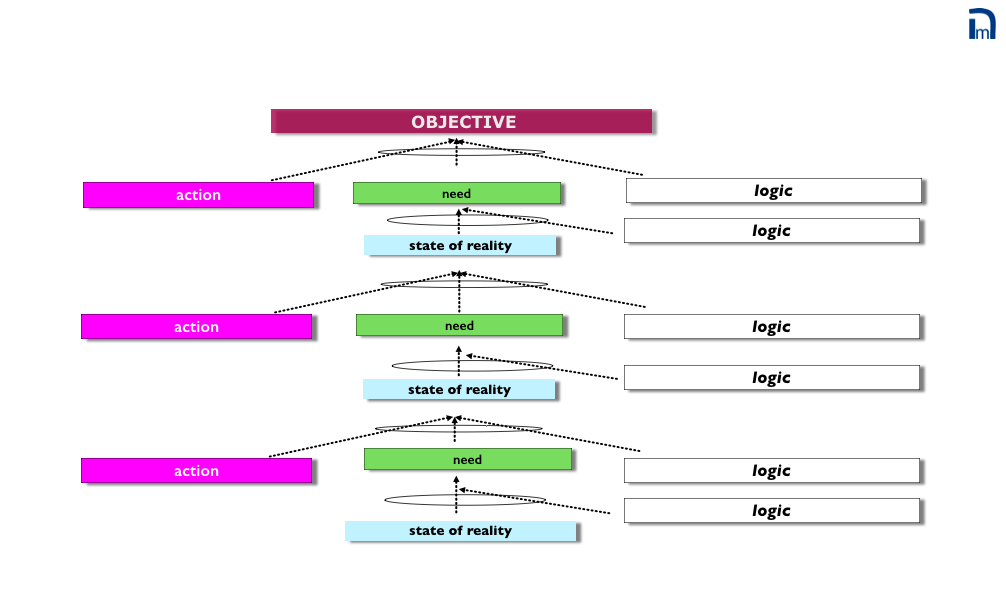
You need people to do things and to do them in a certain way, but so often they just don’t get it. To paraphrase Nina Simone, the Animals, Elvis Costello and many others, you’re intentions may be good and you don’t want to be misunderstood. So how do you get people to do things? By telling them? By giving them a list? We believe that a much more empowering way of communicating should be based on conveying the logic, the “why”, rather than the detailed instructions, or the “how”. Why do we claim that?
Empowering someone means giving him/her the“power” to operate. Giving someone a detailed list of things to do is the exact opposite.
Why? Because:
- It takes away the ownership of the action, i.e. it prevents the person from “inventing” the way of doing it;
- Almost invariably, a detailed list triggers the production of negative reservations which run the risk of remaining unresolved;
- Very likely, the person will “interpret” the list, investing effort in an unwanted direction, causing frustration and lack of results.
A Thinking Process for Clear and Empowering Instructions
If we want to give somebody clear, truly empowering instructions and not be misunderstood we must :
- specify the need we are trying to satisfy (why we want them to take action)
- define the action that, if taken, would fulfil the need
- explain the logic ; why we claim that the action will satisfy the need.
There is a powerful Thinking Process that enables us to accomplish this. It comes from the Theory of Constraints and it’s called the Transition Tree (TrT). This is the “how to” tree. It shows the detailed logic of how to move from the present into the desired future. At the bottom of the tree there are statements that describe the present state of reality. The top of the tree is the goal – the expected change of reality following the conclusion of all the proposed actions.
The Transition Tree contains the following 5 steps:
- State the need for the action
- Describe the action itself
- Explain why the action will fulfill the need
- Describe the result of the action (new state of reality)
- State why the next step is needed
If that sounds complicated, bear in mind that this tool is used successfully with kindergarten children so they know not just what to do in certain circumstances but also why.
What We Achieve with Clear and Empowering Instructions
When we give clear instructions we achieve four important results :
a) we drastically reduce the possibility of misunderstandings ;
b) we give the listener the possibility to follow the entire logic of our request ;
c) we provide the listener with the possibility of fulfilling our need with a different action, increasing in this way his ownership of the solution ;
d) we enable the listener to check for “holes” in our thinking process, or simply give him the chance to raise negative reservations that will lead to a more rounded, comprehensive solution.
The Theory of Constraints (TOC) and the Theory of Profound Knowledge (TPK) aresystem theories. Their goal is to provide a framework for analyzing and improving the general the we are in. Systems are funny creatures; under the stimulus of forces, they evolve in ways that are not easy to understand. Such an evolution is named “non-linear”, to mean that very similar systems, under very similar circumstances can evolve, change state, in completely different ways.
A Thinking Process for Improving Just About Everything
Probably, the most powerful use of the Transition Tree (TrT) is in designing the desired course of action, inasmuch as it takes into account the intrinsic non-linearity of the system. While forcing us to always explain the logic inspiring the different actions that we want to take in order to modify the states of the system, the TrT enhances our ability to consider all the possible implications of these actions. In this way it enables us to “predict” with reasonable precision how the system is going to evolve and anticipate potential negative implications. In some respects the Transition Tree plays a similar role to the control chart used for Statistical Process Control: it facilitates focusing while helping us to understand and anticipate future events.
The Misalignment Cloud that we looked at in our post Empowerment: 5 Questions to Help People Do Their Jobs and the Transition Tree cut down considerably on the time wasting which afflicts many organizations. They provide people with an intrinsic motivation to do their own job.
The sequence in which control charts, the Misalignment Cloud and the Transition Tree should be used depends on the characteristics of the system. However, all three act effectively to reduce variation, the enemy number one of Quality and good management.
The Intelligent Management Partners are trusted advisors to leaders of organizations. We blog about how to shift your thinking towards broader, systemic possibilities for yourself and your organization. Sign up to our blog here. Intelligent Management provides education and training on systemic management, W. Edwards Deming’s management philosophy and the Theory of Constraints (Decalogue methodology) in North America and Europe.
See our new books The Human Constraint – a business novel that has sold in 27 countries so far and ‘Quality, Involvement, Flow: The Systemic Organization’ from CRC Press, New York. by our Founder Dr. Domenico Lepore, Dr. .Angela Montgomery and Dr. Giovanni Siepe.





Leave a Reply